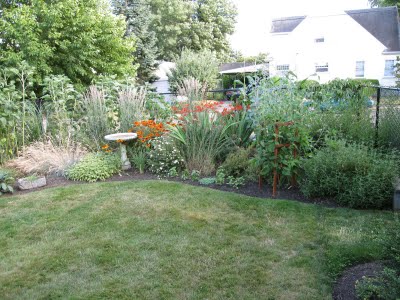First, a refresher on its summer aspect, below.
Being the eternal optimist, I earlier figured that zonal constraints just didn't apply to me or my plant choices. I don't mean I planted with complete abandon, but I definitely imagined a more cold-tolerant group of plants than I apparently have ended up with. Below is a view of the same area of the garden this winter.

There are some major holes in our privacy screen created by plants that are either under-performing or dying a messy death.
First off, the cortaderia selloana pampas grass has been slammed for the second time by our weather. It was planned as a large, evergreen anchor for the southeast corner of the garden. Not happening.

All the flaxes have likewise been slammed into sad little piles of reddish-brown strips.

They were going to be 4-5-foot red-foliaged specimens on the south end of the garden.
Not this coming year, anyway.
Looking from the south sidewalk, our back garden privacy is practically non-existent.
One area is somewhat private, below. The eucalypt and the ceanothus, assisted by the pyracantha and evergreen clematis, are screening and covering to an extent. This is the most satisfying section of the Mediterranean garden area, from either side of the fence.
So what to do with these holes?
The fig is deciduous, so it will be back in the spring. If I'm patient enough, I can shape and then underplant it when it gains some height, getting some winter coverage of that part of the fence. The trachycarpus fortunei windmill palm is a nice blob of winter green and will have more presence as it gets taller. It will also allow for underplanting as it grows.
The pampas may need to go. The feather reed grasses are nice in summer, but were never intended as a long-term solution. One option is to move the arctostaphylos 'Austin Griffiths' from the Northwest Territory area to a place in the Mediterranean garden. It provides a similar open-foliaged screening style to the eucalypt, and it needs to be moved anyway before it gets any larger.
Whatever my eventual decisions, this is the perfect time for the MulchMaid to consider them. As much as I love summer, I value my views out of our windows year-round: they need to be satisfying in the cold light of winter, as well.
Incidentally, my apologies for the erratic spacing and placement of elements in the last couple of posts: I'm having a terrible time with Blogger's new "improved" posting interface. Technology.....yeah.









I have similar issues now, my evergreen plans always seem more grand in the summer. Not mediterranean, but I've found Choisya ternata to be an agreeable evergreen shrub. It's surrounded by yuccas and a trachycarpus and then some other plants that wouldn't fit your motif - but when winter rolls around, it does a good job keeping the area filled in, and keeping my patio private.
ReplyDeleteOh bummer, these super cold winters are really putting a dent into the semi-tropical gardening ambitions of many a NY gardener! I think we need to maybe give up on the more tender Med. plants unless this two-year cycle proves to be a complete fluke. For a hardy screen, do you hate arbutus? I can't remember if you already ruled that one out. Small-leaf hebes seem to have come through okay, although they're not so big. Hm. Hope you get some good recovery there, I know you do not want to look at that fence all year long!
ReplyDeleteWhat's with our weather lately? Hard to predict what will work any more, but wandering through Joy Creeks's display gardens is a good way to pick up ideas. The nursery will be closed until March, but I think you can still roam the grounds.
ReplyDeleteHi Jane~~ I completely messed up my last post by trying to use that new Compose/editor whatever you call it. I have never been so frustrated with my capabilities on line. I felt like I was back in beginner mode. Other than the larger window, the thing seems to be a sham. And no spell check? Hello? Anyway, thanks for letting me rant. I optioned out of the new, preferring the tried and [mostly] true older version, thank you very much.
ReplyDeleteNow, your planting: The summer version is lovely, full of varying shapes and textures. It definitely draws the eye, especially with the birdbath focal point. My Phormiums look very similar to your grasses, flat and tired. I concur with Megan on Choisya. They can tend a bit of die-back if it gets really cold but my two, mother and child planted at opposite ends of my lot, are drought tolerant. Rosemary is a tough cookie too. And if you like silvery evergreen foliage and red berries, how about Cotoneaster lacteus? My plant is about 10 years old. I've limbed it up [despite warnings that this plant doesn't like pruning] from the bottom and it has a weeping form. Mine never gets summer water yet thrives. One final great evergreen fast-grower is the native Pacific Wax Myrtle. Myrica californica.
I look forward to seeing your results. You're so right. Winter, with its bare bones is a great time to design and dream.
Hello Jane, and thank you for stopping by my blog and introducing yourself. You had asked a question as to our garden location: we are in the Willamette valley and face the coastal range.
ReplyDeleteWe too have pampas and phormiums and they look like yours, but last winter when we had such a freeze, we simply cut everything to the ground and they came back proudly this past summer. One of the evergreens we love is an escallonia and has done beautifully over the years. Diana